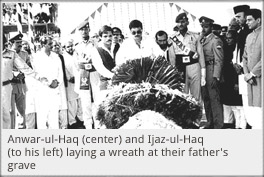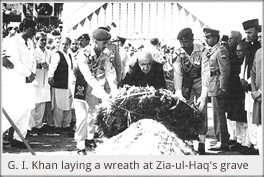General Muhammad Zia-ul-Haq was killed in an air crash on August 17, 1988. He had gone to Bhawalpur to see a demonstration of tanks where he was accompanied by a number of Generals, including the Chairman Joint Chiefs of Staff Committee, Chief of General Staff, high-ranking Military Attaches, as well as the U. S. Ambassador to Pakistan. On his return journey, his military transport aircraft, a C-130, exploded in mid-air a few minutes after takeoff from Bhawalpur airport, killing all passengers aboard including the President.
This tragic air disaster was the worst in Pakistan’s history and was unprecedented in the history of military aircraft. The cause of the crash was not known and the enquiry report was never made public.

After the crash, a high level meeting was held in Islamabad to decide the question of succession. Some of the participants in the meeting were in favor of imposition of Martial Law. However the military Chief present did not support the idea. Under the Constitution, whenever the office of President becomes vacant by reason of death or resignation, or removal of the President, the Chairman of Senate acts as the President until a new President is elected.

This article was last updated on Sunday, June 01, 2003



